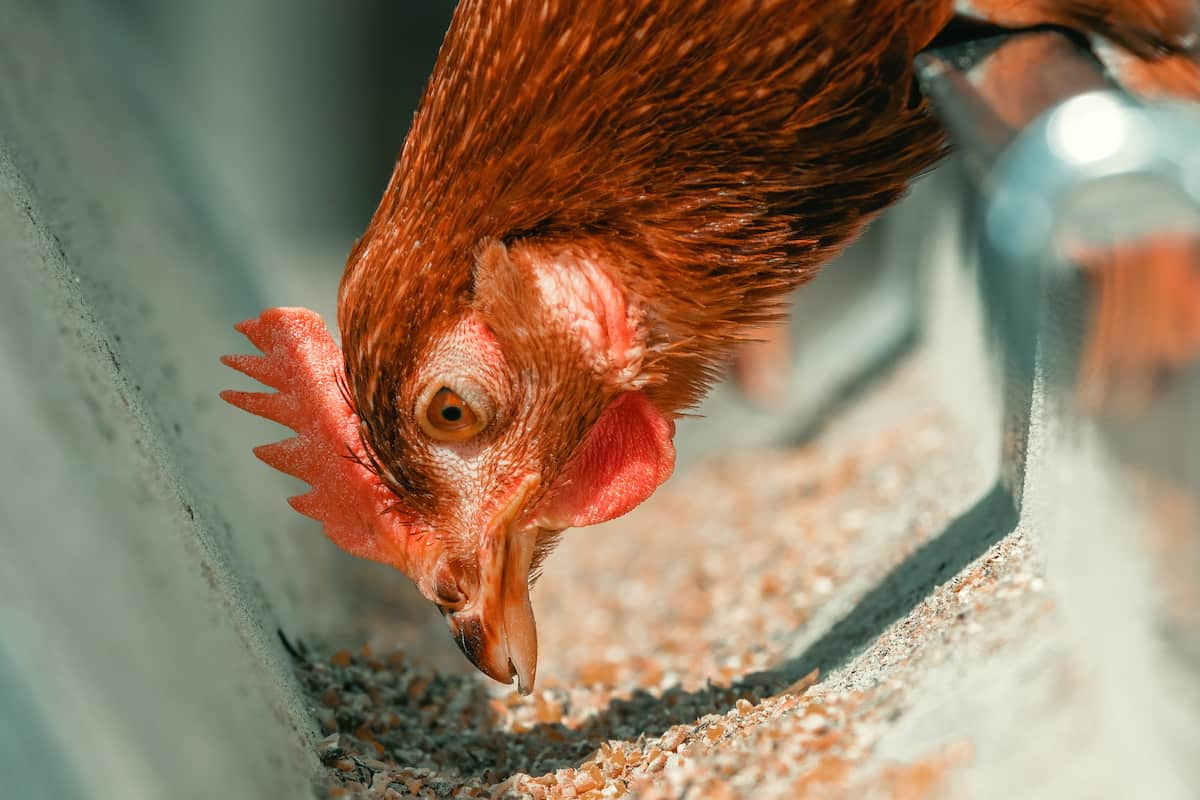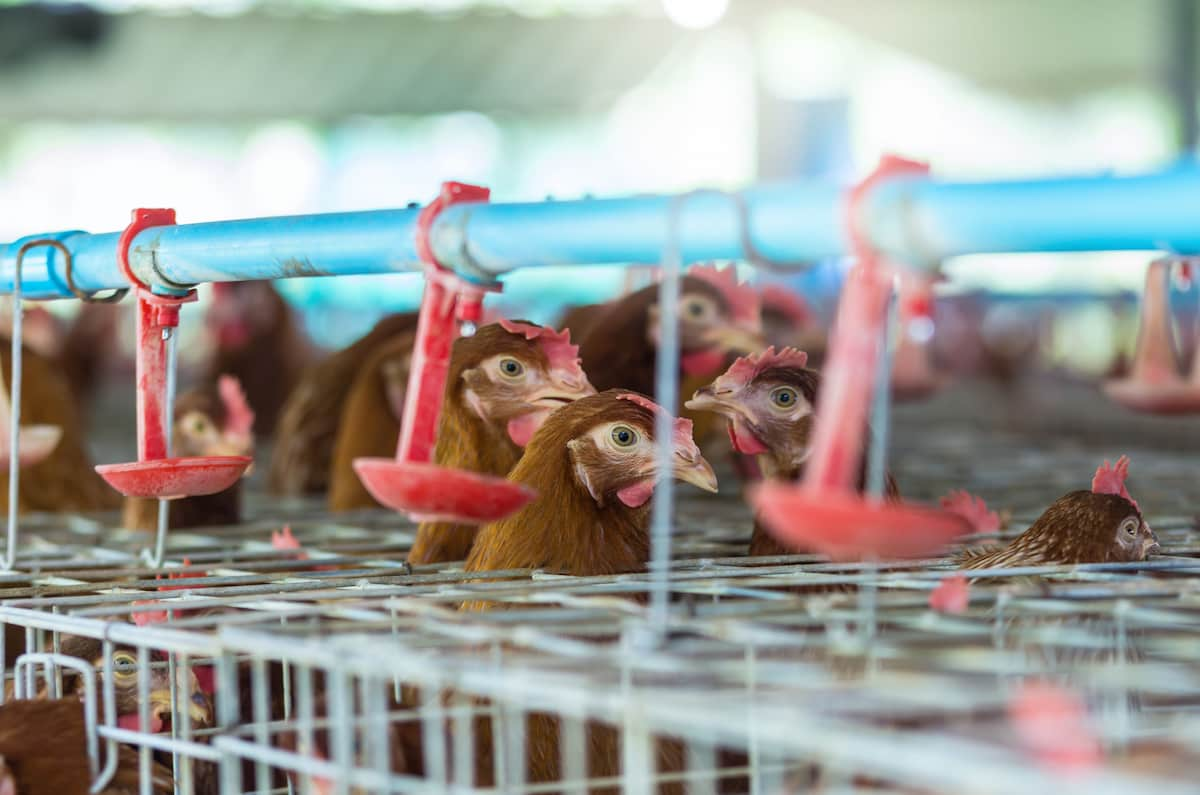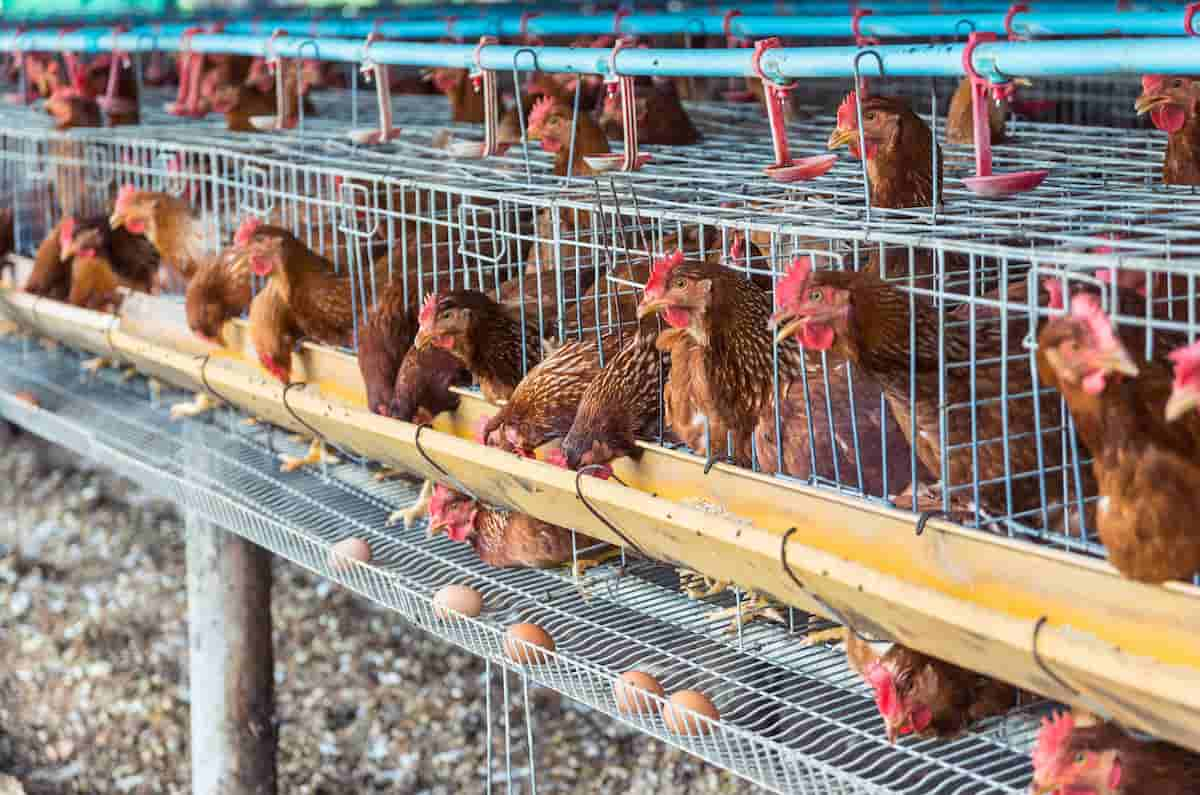Their nutrition heavily influences layer birds’ performance. Managing feed is the most important practice to achieve egg production at the right time, maximum peak production, long-standing peak production, standard egg size, good cull bird weight, and lower feed costs per egg. Every week from the first week to the 18th week of age, the birds with less body weight should be separated, and special care must be taken with those birds to ensure uniformity.

When birds are fed standard feed prepared according to nutrient specifications, they will achieve the recommended body weight. It depends on the bird’s breed, age, climate, and nutritional requirements. Hence, feed formulations should be prepared based on bird nutritional requirements. The feed intake is lower during summer so the formulation will be revised based on the feed consumed.
Feed Management in Layer Chickens
Feeds for Layers
The quality and quantity of feed and the feeding method contribute greatly to the environmental component, controlling productivity. In poultry production, this feed accounts for 65 – 70% of expenditures. Because of this, it is important to take care when feeding. In addition to being balanced, the feed must be free of toxic principles, bacterial contamination, and anti-nutritional factors.
A drop in egg production or stunted growth will result from under and overfeeding, which depletes body reserves and accumulates excessive fat. In layer chicken feed, the following ingredients should be present.
- Wheat
- Oats
- Barley
- Corn
- Millet
- Rye
- Flax
- Skim milk and Buttermilk
- By-products of grain like wheat middlings, shorts, bran, barley meal, oat flour, oat middlings, and oat feed
Essential Nutrients
All classes of poultry require the following six types of nutrients for survival, growth, production, and reproduction. Most of these essentials are provided by nature through the pasture, bugs, insects, gravel, grains, seeds, and sunshine. In indoor feeding of young or adult poultry, the attendant must provide these same requirements sufficiently but not excessively.
- Protein
- Carbohydrates
- Fats
- Minerals
- Vitamins
- Water
Feeding of Baby Chickens (0-8 Weeks)
- From the time the baby chickens are born until the end of the 8th week of their lives, they are fed a feed called a baby chicken feed. It contains about 2700 kilocalories of metabolizable energy and 22 percent crude protein.
- Filling the feeders at least four times a day during the first few weeks is recommended. Before filling feeders, litter materials should be cleaned out, and new feed should be mixed thoroughly with leftover feed before being placed in the feeders. Baby chickens should be encouraged to eat by keeping the feeders full at the beginning. In addition, the feed level in the feeder should not exceed half full.
- Each baby chicken should have a 5 cm (2 inches) feeder space and a 2.5 cm (1 inch) water space during these eight weeks.
- The baby chickens must be fed at the correct height by placing feeders at the correct height.
- Ensure that feed sources are distributed uniformly throughout the house, so birds are not far from them, regardless of location. Baby chickens need this attention during the early days of their lives.
- Feeders should not be placed directly under the heat source in the brooding period. It is best to arrange the feeders parallel to the rays of natural light falling in the house after removing the brooder.
- Feeders should be lifted at one end before the new feed is put into that. Choose the end far from the light, allowing all the leftover feeds to go to that end.
- Insufficient feeders in a baby chicken house may lead to crowding and spillage. It is also essential to maintain the feeder height throughout the raising process.
In case you missed it: How to Start Layer Chicken Farming in 10 Steps: Business Plan, Management, and Care

Grower Feeding (9-20 Weeks)
- A grower feed may be used for up to 20 weeks instead of a starter feed after eight weeks of age.
- After about 14 weeks of age, grower feed can be replaced with developer feed, which prepares young chickens to lay eggs.
- For growers or pullets, feeding management should aim to maintain a growth rate that will result in the pullets reaching gender maturity at the appropriate age and weight.
- Grower rations have a lower energy and protein content than chick rations. Sometimes, a pre-lay ration containing an increased calcium level is recommended for 2-3 weeks before egg laying.
- Chickens are less energy-demanding once fully feathered.
Layer Feeding (20-72 Weeks)
- The layer ration is designed to maximize egg production. In terms of egg numbers, size, or mass, this can be expressed in various ways.
- Due to their smaller size and slower growth rate, layer birds consume less feed than broilers.
- As soon as the chicken starts laying eggs, layer feed is used. For chickens that lay table eggs, layer feed is formulated.
- The energy and protein content of layer feed is higher than that of grower feed. Furthermore, it contains extra calcium so the chicken can lay eggs with strong shells compared to grower feed.
- In addition to this feed, the first egg will be laid approximately 20 weeks after birth or when the babies are about 20 weeks old.
Ration for Layers Chickens Should Contain the Following Nutrients
| Nutrients | Baby chicken (0 – 8 weeks) | Grower (9 -20 weeks) | Layer (21-72 weeks) |
| Moisture(maximum) (%) | 10 | 10 | 10 |
| Crude protein(min) (%) | 22 | 16 | 18 |
| Metabolizable energy (min) Kcal/Kg | 2800 | 2600 | 2700 |
| Crude fibre (max) (%) | 7 | 8 | 8 |
| Calcium (%) | 1 | 1 | 2.75 |
| Available phosphorus (min) % | 0.5 | 0.5 | 0.5 |
| Lysine(min) (%) | 1 | 0.7 | 0.5 |
| Methionine (min) (%) | 0.45 | 0.25 | 0.25 |
| Manganese mg/kg | 55 | 55 | 55 |
| Vit A IU/Kg | 4000 | 4000 | 8000 |
| Vit D IU/Kg | 600 | 600 | 1200 |
| Feed consumption Kg | 2 | 5.5 | 40.0 (110-120 grams/day/bird) |
Water Requirements for Layer Chickens
In laying flocks, water is one of the most important nutrients. Thus, a water shortage for a few hours reduces egg production. Water softens feed and transports it through the digestive tract. Water transports nutrients from the digestive tract to cells, removing waste products as a blood component (90% of blood content).
A bird can also be cooled through evaporation by water. Because birds do not have sweat glands, they lose heat through rapid respiration in the air sacs and lungs. Since age, body condition, diet, temperature, water quality, humidity, and temperature all affect the amount of water a bird needs; there is no precise quantity requirement for water.
In case you missed it: How to Start Free Range Chicken Farming in 10 Steps: Business Plan, Management, and Care

Conclusion
Raw materials, cost, and availability must be considered when preparing the feed formulation. The breed’s nutrition requirements, the birds’ age, and the amount of feed the birds consume should be considered when formulating their feed. Through proper digestion and absorption of nutrients, emulsifiers and enzymes need to be added to feed raw materials to maximize their nutritional value.
- Feed Your Flock for Less: Top 10 Tips to Save on Chicken Feed
- Ultimate Guide to Ossabaw Island Hog: Breeding, Raising, Diet, and Care
- Hatching Answers: The Top 10 Reasons Your Chickens Aren’t Laying Eggs
- Eggs and Economics: Breaking Down the Cost of Raising Backyard Chickens
- Defend Your Greens: Proven Methods to Keep Iguanas Out of Your Garden
- Ultimate Guide to Cinnamon Queen Chicken: A Comprehensive Guide for Beginners
- Ultimate Guide to California Tan Chicken: Breeding, Raising, Diet, Egg-Production and Care
- Ultimate Guide to Marsh Daisy Chicken: Breeding, Raising, Diet, and Care
- 10 Types of Chicken Farming Businesses You Can Start for Profits